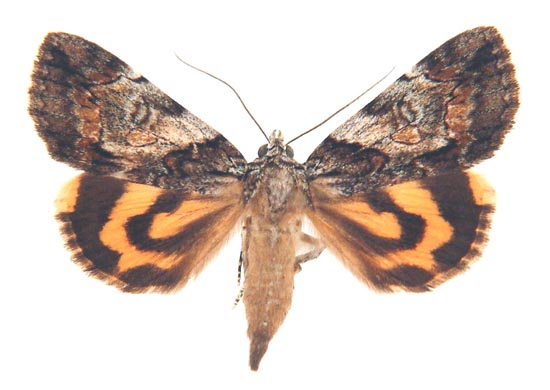Catocala pretiosa texarkana
Catocala pretiosa texarkana
kah-TOCK-uh-lahmpret-ee-OH-suhmtex-are-KAN-uh
Brower, 1976

Catocala pretiosa texarkana = Catocala pretiosa, by of Vernon A. Brou, Louisiana.
This site has been created by
Bill Oehlke. Comments, suggestions and/or additional information are welcomed by Bill.
| TAXONOMY:
Superfamily: Noctuoidea
Family: Erebidae, Leach, [1815]
Subfamily: Erebinae, Leach, [1815]
Tribe: Catocalini, Boisduval, [1828]
Genus: Catocala, Schrank, 1802
|
DISTRIBUTION:
Catocala texarkana, the Texarkana Underwing, (wingspan: 40-50mm), flies from Florida to
Texas.
This subspecies is now equated with the nominate species Catocala pretiosa.
It has also been reported in
Alabama,
Arkansas,
Georgia,
Louisiana,
Mississippi,
Missouri,
North Carolina,
Oklahoma and
South Carolina.
The median area is quite light with a wide whitish band paralleling the antemedial line from the costa almost to the inner margin. The subreniform spot is
distinctly brown.
The inner black band on the hindwing forms a complete loop and mingles with dark scaling along the inner margin. The outer black band is
almost broken. The orange-yellow fringe is heavily checked with black.
FLIGHT TIMES AND PREFERRED FOOD PLANTS:
Catocala pretiosa texarkana are on the wing from May to June.
The Catocala pretiosa texarkana caterpillar feeds on Crataegus.
ECLOSION:
Adults eclose from pupae at soil surface.
SCENTING AND MATING:
Catocala pretiosa texarkana females emit an airbourne pheromone and males use their antennae to track the scent plume.
EGGS, CATERPILLARS, COCOONS, AND PUPAE:
Eggs are deposited on tree bark in the fall and hatch the following spring.
Larval Food Plants
Listed below are primary food plant(s) and alternate food plants. It is hoped that this alphabetical listing followed by the common
name of the foodplant will prove useful. The list is not exhaustive, although some species seem very host specific.
Experimenting with closely related foodplants is worthwhile.
Crataegus.......
| Hawthorn
|
This page is brought to you by Bill Oehlke and the
WLSS. Pages are on space rented from Bizland. If you would like to become a "Patron of the Sphingidae/Catocala Sites",
contact Bill.
Please send sightings/images to Bill. I will do my best to respond to requests for identification help.
Enjoy one of nature's wonderments: Live Saturniidae (Giant Silkmoth) cocoons.

|

To show appreciation for this site, click on the flashing
butterfly to the left, a link to many worldwide insect sites. |


